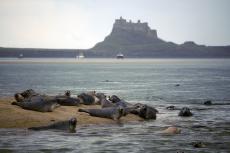Diving with Seals of the Farne Islands
The Farne Islands are a small group of some 33 rocks and islets (depending on the state of the tide which has a rise and fall of over 6m or 20ft) located off the north Northumberland coast of England. At full tide, only 23 larger rocks and islands are visible, but all of those are eye catching. The entire group are a National Trust protected area and have numerous wildlife preserves, notably for their seabirds and seals.
Tags & Taxonomy
There are numerous sightseeing boats and dive boats that run regular trips to the islands, but Paul Walker of Farne Discovery (www.farneislanddivers.co.uk) I personally feel, has the most experience and empathy for the seals and the most knowledge about the hidden shoals, wrecks, reefs and currents, which can play havoc for inexperienced divers and boat skippers.
Geologically, the islands are part of what is known as The Great Whin Sill, a 30m (100ft) thick seam of diamond hard dolorite that was formed in recent geological time. Its aspect is of columnar shape cut with numerous fissures, the most obvious being ‘The Stack’ off the southern edge of Farne Island, which is over 20m (66ft) high. Staple Island has three huge individual stacks called The Pinnacles. Most of the larger islands are now topped with peat and are very fertile with the droppings of the seabirds mixed with seaweeds.
Built in 1811 and 1826, there are two lighthouses on the islands—one on Farne Island and the other out on the Longstone. Now fully automated, the very early lighthouses first burned their rudimentary light to warn sailors of the treacherous reefs and shoals back in the 16th century.
Most people know of the Farne Islands from the outstanding heroism of Grace Darling and her father William Darling, one of the lighthouse keepers of the Longstone Lighthouse. On 7 September 1838, Grace Darling and her father rowed out to the shipwrecked Forfarshire and managed to rescue nine seamen in absolutely atrocious sea conditions. This act of selfless heroism attracted massive media attention and made Grace Darling a national heroine.
The Farne Islands were first inhabited by St.Aiden in 635AD, before he became the Bishop of Lindisfarne. St.Cuthbert followed in his Holy footsteps and settled on the islands in 676AD where he built a ‘cell’ for himself, a well for fresh water and rooms or ‘hospitium’ for other visiting monks.
In ancient legend, St.Cuthbert drove out all the evil demons and spirits from the inner islands, yet their strange wails and screams could still be heard on the farthest rocks and were thought to be the spirits of drowned sailors; now it is more generally accepted as the sounds from the huge colony of grey seals...
Download the full article ⬇︎

Originally published
X-Ray Mag #54
Diving Cocos Island; British Columbia's Southern Gulf Islands; Seals of Farne Islands; The Lermontov Wreck off New Zealand; Japan's Yonaguni Jima; Finland's Ojamo Mine; Expedition to the Maldives; Dive Fitness Programs for Divers; Scuba Instructor Training; Tech: Self-Sufficiency vs Team Diving; Macro with Mirrorless Cameras; Peter Hughes Profile; Frozen Water: Amanda Brisbane's Sand Cast Glass; Plus news and discoveries, equipment and training news, books and media, underwater photo and video equipment, turtle news, shark tales, whale tales and much more...




































